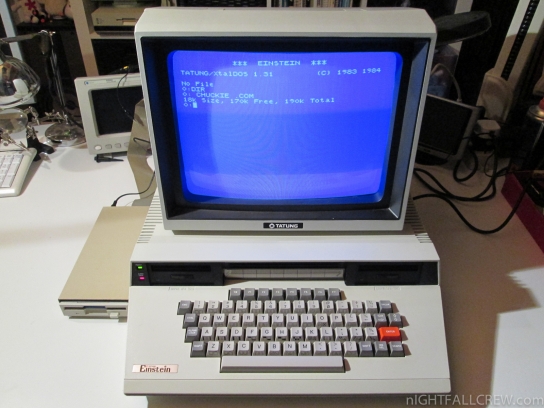About 3 months ago i have repaired my Tatung Einstein with stability problems, after a few minutes the screen was filled with random characters. Below the replacement parts:
- 2 x 74LS157 (IOO6/IOO7) Multiplexer.
On the same day has broken the Tatung TC-01 Monitor, the vertical sync is died without any way of adjustment. Yesterday, instead of celebrating Easter, i have tried to repair the monitor, the faulty component was as follows:
- 1 x TDA 2578A Sync Mixer.
Very happy i have connected the Tatung Einstein to the monitor, i have tried a few games and after 15 minutes the Tatung (computer) decided to die. I spent more hours to understand what could have happened, oh! found it, some ram burned. Below the replacement parts:
- 3 x RAM 4264 (IO11/IO10/IO8)
What could happen again?
I also did the dump of the eprom (rom), the download below.
I have gathered all photos of some phases of the work that i have done on the Tatung Einstein TC01.
Below the descriptions:
- Replaced 2 x 74LS157 (IOO6/IOO7) Multiplexer.
- Replaced UK Power Connector.
- Repaired some not working keys.
- External Floppy Drive 3.5″. Yes, it’s better than 3″ ;-D
Todo:
- Repair the defect of the vertical sync of the Monitor Tatung TM01

Autopsy:
from Wikipedia homepage:
The Einstein was released in the United Kingdom in the summer of 1984, and 5,000 were exported back to Taipei later that year. A Tatung monitor (monochrome or colour) and dot matrix printer were also available as options, plus external disc drives and an 80 column display card. It was also capable of emulating the Spectrum 48k with the “Speculator” addon.
More expensive than most of its rivals, and lacking an obvious niche market other than technically-advanced home programmers, the Einstein was commercially unsuccessful. A later, revised version, called the Tatung Einstein 256 suffered a similar fate.
The machine was physically large, with an option for one or two built-in three-inch floppy disk drives manufactured by Hitachi. At the time, most home computers used ordinary tape recorders for storage. Another unusual feature of the Einstein was that on start-up the computer entered a simple machine code monitor, called MOS (Machine Operating System). A variety of software could then be loaded from disk, including a CP/M-compatible operating system called Xtal DOS (pronounced ‘Crystal DOS’, created by Crystal Computers in Torquay), and a BASIC interpreter (Xtal BASIC). Thanks to the reliability of the machine, and ample memory, the machine proved useful by many software houses to use for programming, and then porting the code to the machines they were made for, Spectrum 48k, Amstrad CPC, Commodore C64, this later stopped when the PC and Atari ST would emerge as the development systems of choice.
source: wikipedia









































Recent Comments